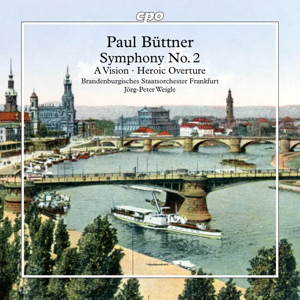
Paul Büttner (1870-1943)
Heroic Overture in C major (1925)
Prelude, Fugue and Epilogue: A Vision (1922)
Symphony No.2 in G major (1902)
Brandenburg Staatsorchester Frankfurt/Jörg-Peter Weigle
rec. 2022, Messehalle, Frankfurt, Germany
cpo 555 482-2 [73]
Paul Büttner was a well-established German composer, as well as holding appointments as a choral and orchestral conductor and teacher. He may have been a near-contemporary of Strauss, and a decade older than Mahler, but his music nestles toward the more conventional end of the German symphonic tradition. The three big works here reflect elements of that traditionally-minded musical persona very adeptly.
The Heroic Overture owes something to a Schumann-Brahms nexus. After a serpentine opening, its brassy nature eventually generates a stout, happy tune – he’s never short of a good tune – but the overall impression is of a lax sense of structural development or one that’s rhapsodic to no great advantage. Still, observers at the time of its premiere in 1925 hailed its ‘orchestral magnificence’ and annotator Christoph Schlüren writes of its ‘unpredictable’ development that ends in a ‘radiant conclusion in an irresistible stretta’. Take your pick.
The Prelude, Fugue and Epilogue: A Vision was written a few years earlier in 1922. Its opening panel is confident, lyric and finely orchestrated and moves seamlessly into the Fugue with a slightly Brucknerian sense of the serious and sonorous. The Epilogue instead offers a reserved sense of melancholy that moves toward a Straussian twilit glow, ending with quiet radiance.
These two relatively large-scaled orchestral works – the Prelude, Fugue and Epilogue lasts 21-minutes – preface the much earlier Second Symphony of 1902. It’s clear that he was a fine orchestrator and had a penchant for high winds – something one can hear in the other two works – and wrote attractive themes, though one doesn’t always feel that they’re distinctive. There’s quite a lot that’s Schumannesque in the development of the first movement and a Rhenish-like use of horns. The tuneful and ebullient Scherzo is perhaps a little over-extended. The finale opens in a brief moment of Franckian stygian gloom but quickly adopts a bluff profile to unleash some variations, again some decidedly Schumann-leaning, others contrasting, and again full of independent wind writing. A jolly March theme brings things to a satisfactory close.
The Heroic Overture has been recorded before back in 1974 by the Berlin Radio S.O. under Hans-Peter Frank on Sterling where it was coupled with the Fourth Symphony (review – review) and I’m with both my colleagues in their judgements on the Overture. In CPO’s recording, the Brandenburg Staatsorchester Frankfurt is directed by Jörg-Peter Weigle who take far more time over the Overture than Frank did, which stretches its fabric to stretching point and not, therefore, to its advantage. The orchestra sounds capable but rather undernourished and understaffed in tuttis with quite thin string tone.
Schlüren’s extensive notes are excellent and tell you everything you need to know as well as mounting a stout defence of the composer, not least from Büttner atheists such as myself.
Jonathan Woolf
Buying this recording via the link below generates revenue for MWI, which helps the site remain free.


















